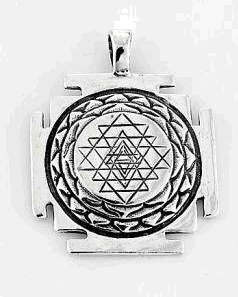Yantras
Types of yantras and there benefits in life
| Maha Sudharsan Yantra - | To Protect from Negative Influences |
| Thripura Sundhari Yantra - | To Attract Particular People |
| Sree Yantra - | For Prosperity |
| Veera Bhatra Yantra - | For Couples |
| Swayam Vara Yantra - | To Attract a Marriage Partner |
| Dhanwathari Yantra - | To Cure Diseases |
| Rajagopala Yantra - | For Progress in Current Job |
| Saraswathy Yantra - | For Education |
| Santhana Gopala Yantra - | To Bless a Childless Couple with Healthy Children |
| Bala Yantra - | For Small Kids |
| Ganesha Yantra - | To Remove Hindrances and Obstacles in Life |
| Vasthu Yantra - | For Vasthu (architectural) Issues |
| Kubera Yanthram - | For Wealth |

Yantra, directly translated from Sanskrit, means ‘instrument’ or ‘machine’ which is derived from the root yam meaning to control or subdue. Thus, a yantra is a talisman employed by its wearer as a way of fending off ‘bad’ vibes or ‘evil’ karma emitted from the planets.
Yantras are made up from Vedic symbols, comprising of straight lines, squares, rectangles, triangles and circles. These symbols are so precise in design, that even the angles employed are determined to the last degree. Some talismans may also comprise of numbers and letters of the 'Dev Nagari' script.
These symbols represent the five basic elements: Earth, Wind, Fire, Air, Water and Ether. Each element is associated with certain properties. For example Earth denotes, among other things, stability, patience, material happiness and success. While Wind represents dishonour, sorrow and ignorance. These symbols are arranged so as to enhance one property and enervate the other. Yantras are usually made from metallic materials, but can also be made from crystals or even plant leaves. Certain materials are more suited to certain yantras.
Yantras are incredibly complex in nature and come in various different forms, for example, it can come in the form of a pendent. In most cases the yantras are folded up and encased in a silver or gold casing. The reason behind this is that most yantras are to big to be worn as is, so they need to be folded up. Also some people feel that wearing a yantra is a very private matter and don’t want it on display.
A popular usage in the West is as symbols or geometric shapes. Traditionally, these shapes are used in Tantric traditions of Hindu mythology and are used to balance the mind so as to focus on spiritual concepts.
A yantra is only active when it has been consecrated or, 'Energized', then it becomes a Power yantra. A consecrated, Power yantra is considered to be the dwelling of the Gods and Deities it represents. In fact yantra also means 'Abode' or ‘Dwelling Place’. Thus, the yantra is the dwelling place or home of the gods. Once it has been energized, a yantra becomes an independent source of spiritual energy that not only influences those who worship it, or wear it, but also the surroundings in which it is placed.
Yantras specially prepared and energized according to the ancient scriptures of the Vedas. They are all handmade and energised by a swami (a Vedic Priest of India) with years of experience taking great care to ensure that the correct mantras are chanted, clearly recited and correctly pronounced during the energizing ceremony. Through the swami’s exceptionally high levels of concentration, developed through years of practicing Yoga and meditation, he/she ensures that the yantras are awakened with positive, unselfish thoughts. Without this, the yantras will not bear the desired results. Along with each yantra you will receive instructions on how it is to be used.
Should you Like a Yantra Suggestion, Please Fill in the form below:
--------------------------

